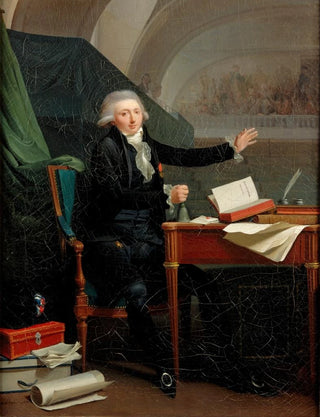Art print | Portrait of Jan Anthony d'Averhoult - Louis Léopold Boilly


View from behind

Frame (optional)
Louis Léopold Boilly’s “Portrait of Jan Anthony d'Averhoult” is an iconic artwork that embodies the elegance and finesse of early 19th-century portraiture. This piece, crafted with remarkable precision, immerses us in the refined universe of French high society of the era. Through the penetrating gaze of the subject, Boilly invites us to explore not only the physical appearance of Jan Anthony d'Averhoult but also the complexity of his character and social status. The mastery of details and the subtle use of light make this work a true window into the past, where each brushstroke tells a story.
Style and uniqueness of the artwork
Boilly’s style is distinguished by its ability to blend realism and idealization. In this art print, every element is carefully designed to convey an impression of dignity and nobility. Jan Anthony d'Averhoult’s sumptuous clothing is rendered with precision, highlighting the richness of textures and colors. The neutral, almost ethereal background emphasizes the subject, creating an intimate and contemplative atmosphere. The slightly relaxed pose of d'Averhoult, combined with his thoughtful expression, offers the viewer a glimpse of his personality. This art print does not merely capture an image; it evokes an era, a culture, and a way of life, while revealing the technical virtuosity of the artist.
The artist and his influence
Louis Léopold Boilly, born in 1761, is a key figure in French painting. His work, which oscillates between portrait, genre scene, and historical painting, demonstrates a keen observation of society of his time. Boilly is known for his ability to seize moments of life, immortalizing characters in their daily routines while endowing them with an aura of grandeur. His influence extends beyond his era, inspiring many artists who followed his path. By capturing the quintessence of bourgeois and aristocratic life, he paved the way for a new approach to portraiture, where the individual is at the center of pictorial narration. His technique, combining precision and expressiveness, continues to inspire.

Matte finish

View from behind

Frame (optional)
Louis Léopold Boilly’s “Portrait of Jan Anthony d'Averhoult” is an iconic artwork that embodies the elegance and finesse of early 19th-century portraiture. This piece, crafted with remarkable precision, immerses us in the refined universe of French high society of the era. Through the penetrating gaze of the subject, Boilly invites us to explore not only the physical appearance of Jan Anthony d'Averhoult but also the complexity of his character and social status. The mastery of details and the subtle use of light make this work a true window into the past, where each brushstroke tells a story.
Style and uniqueness of the artwork
Boilly’s style is distinguished by its ability to blend realism and idealization. In this art print, every element is carefully designed to convey an impression of dignity and nobility. Jan Anthony d'Averhoult’s sumptuous clothing is rendered with precision, highlighting the richness of textures and colors. The neutral, almost ethereal background emphasizes the subject, creating an intimate and contemplative atmosphere. The slightly relaxed pose of d'Averhoult, combined with his thoughtful expression, offers the viewer a glimpse of his personality. This art print does not merely capture an image; it evokes an era, a culture, and a way of life, while revealing the technical virtuosity of the artist.
The artist and his influence
Louis Léopold Boilly, born in 1761, is a key figure in French painting. His work, which oscillates between portrait, genre scene, and historical painting, demonstrates a keen observation of society of his time. Boilly is known for his ability to seize moments of life, immortalizing characters in their daily routines while endowing them with an aura of grandeur. His influence extends beyond his era, inspiring many artists who followed his path. By capturing the quintessence of bourgeois and aristocratic life, he paved the way for a new approach to portraiture, where the individual is at the center of pictorial narration. His technique, combining precision and expressiveness, continues to inspire.






